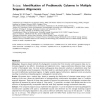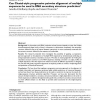372 search results - page 16 / 75 » An Efficient Method for Multiple Sequence Alignment |
JCB
2000
13 years 7 months ago
2000
Multiple sequence alignments (MSAs) are frequently used in the study of families of protein sequences or DNA/RNA sequences. They are a fundamental tool for the understanding of th...
ALMOB
2008
13 years 8 months ago
2008
Motivation: Sequence-based methods for phylogenetic reconstruction from (nucleic acid) sequence data are notoriously plagued by two effects: homoplasies and alignment errors. Larg...
BMCBI
2007
13 years 8 months ago
2007
Background: In ribonucleic acid (RNA) molecules whose function depends on their final, folded three-dimensional shape (such as those in ribosomes or spliceosome complexes), the se...
JCB
2002
13 years 7 months ago
2002
We describe a new algorithm for protein classi cation and the detection of remote homologs. The rationale is to exploit both vertical and horizontal information of a multiple alig...
BMCBI
2008
13 years 8 months ago
2008
Background: Protein remote homology detection and fold recognition are central problems in bioinformatics. Currently, discriminative methods based on support vector machine (SVM) ...


